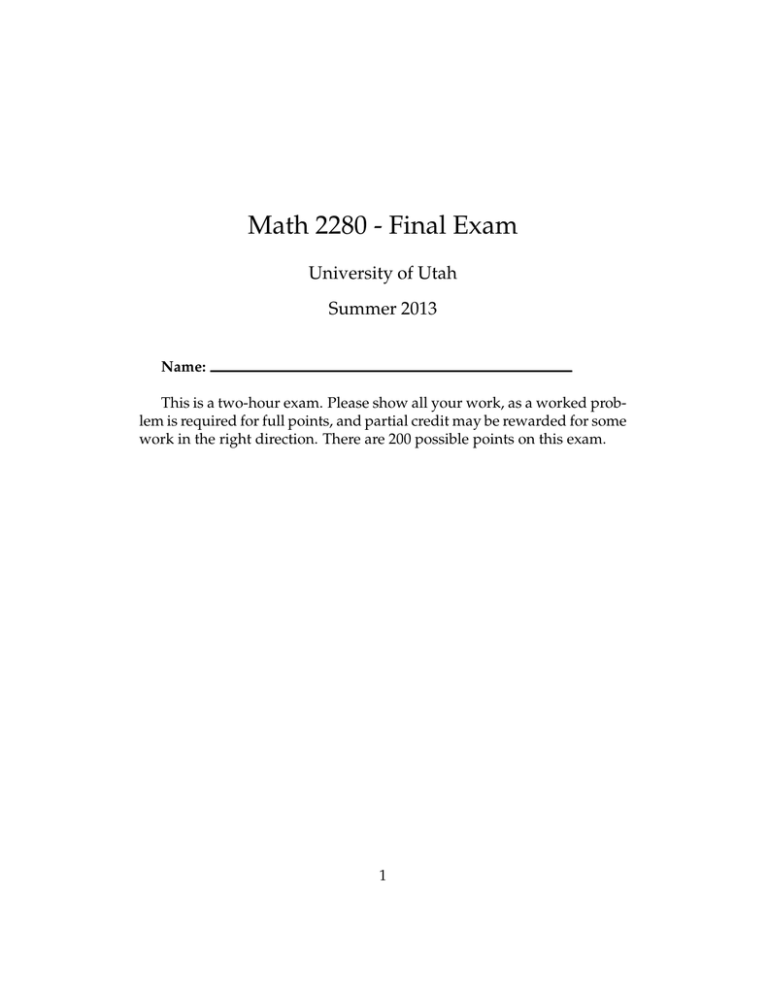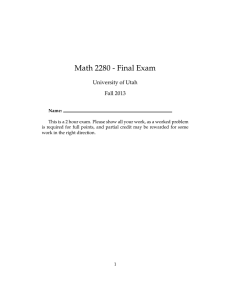Math 2280 - Final Exam University of Utah Summer 2013
advertisement

Math 2280 - Final Exam
University of Utah
Summer 2013
Name:
This is a two-hour exam. Please show all your work, as a worked problem is required for full points, and partial credit may be rewarded for some
work in the right direction. There are 200 possible points on this exam.
1
Things You Might Want to Know
Definitions
Z ∞
L(f (t)) =
e−st f (t)dt.
0
f (t) ∗ g(t) =
Z
t
f (τ )g(t − τ )dτ .
0
Laplace Transforms
L(tn ) =
n!
sn+1
1
s−a
k
L(sin (kt)) = 2
s + k2
s
L(cos (kt)) = 2
s + k2
L(eat ) =
L(δ(t − a)) = e−as
L(u(t − a)f (t − a)) = e−as F (s).
Translation Formula
L(eat f (t)) = F (s − a).
Derivative Formula
L(x(n) ) = sn X(s) − sn−1 x(0) − sn−2 x′ (0) − · · · − sx(n−2) (0) − x(n−1) (0).
2
Fourier Series Definition
For a function f (t) of period 2L the Fourier series is:
∞ a0 X
nπt
nπt
+ bn sin
.
+
an cos
2
L
L
n=1
L
nπt
dt
f (t) cos
L
−L
Z
1 L
nπt
bn =
dt.
f (t) sin
L −L
L
1
an =
L
Z
3
1. Basic Definitions (15 points)
Circle or state the correct answer to the questions about the following
differential equation:
(x3 + 2xex − sin (x))y (5) + x2 y ′ − e−3x y = sinh (x3 + 2)
(3 point) The differential equation is:
Linear
Nonlinear
(3 points) The order of the differential equation is:
(3 points) The corresponding homogeneous equation is:
For the differential equation:
(y ′)2 = 2y + 1
(3 point) The differential equation is:
Linear
(3 point) The order of the differential equation is:
4
Nonlinear
2. Phase Diagrams (20 points)
For the autonomous differential equation:
dx
= x3 − 4x2 + 3x
dt
Find all critical points, draw the corresponding phase diagram, and
indicate whether the critical points are stable, unstable, or semi-stable.
5
3. First-Order Linear ODEs (20 points)
Find the solution to the initial value problem:
y ′ + 2xy = x
y(0) = −2.
6
4. Higher-Order Linear ODEs and Undetermined Coefficients (40 points)
For the ordinary differential equation:
y (3) − 4y ′′ + 3y ′ = 5 + e2x ;
(a) (15 points) What is the homogeneous solution yh to this differential equation?
7
(b) (15 points) Use the method of undetermined coefficients to find
a particular solution to the differential equation:
y (3) − 4y ′′ + 3y ′ = 5 + e2x
from the previous page.
8
(c) (10 points) Find the solution to the initial value problem:
y (3) − 4y ′′ + 3y ′ = 5 + e2x ;
with
y (2) (0) = 0, y ′(0) = 2, y(0) = 1.
9
5. First-Order Systems of ODEs (30 points)
Find the general solution to the system of first-order differential equations:
′
x =
1 −4
4 9
10
x.
More room, if you need it...
11
6. Solving ODEs with Laplace Transforms (30 points)
Find the solution to the initial value problem:
x′′ + 4x = δ(t) + δ(t − π);
x(0) = x′ (0) = 0.
12
More room, if you need it...
13
7. Convolutions (15 points)
Calculate the convolution
f (t) ∗ g(t)
for the functions f (t) = t + 1, g(t) = et .
14
8. Fourier Series (30 points)
The values of the periodic function f (t) in one full period are given.
Find the function’s Fourier series.
−1 −2 < t < 0
1
0<t<2
f (t) =
0 t = {−2, 0}
Extra Credit (5 points) - Use this solution and what you know about
Fourier series to deduce the famous Leibniz formula for π.
15
More room, if you need it...
16




